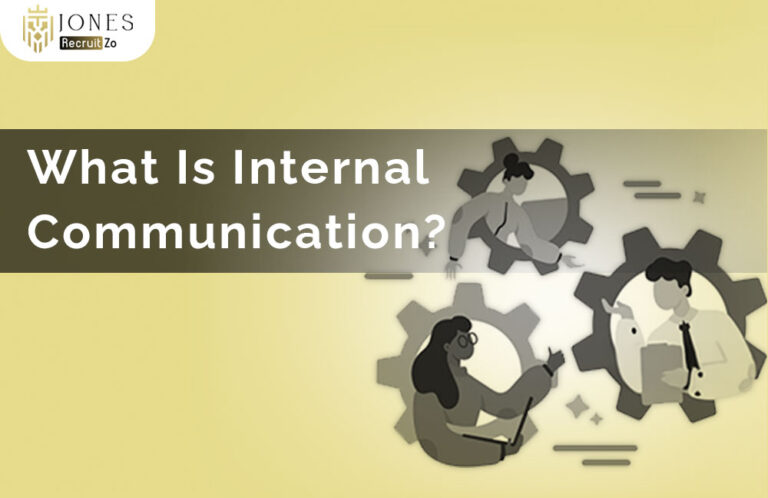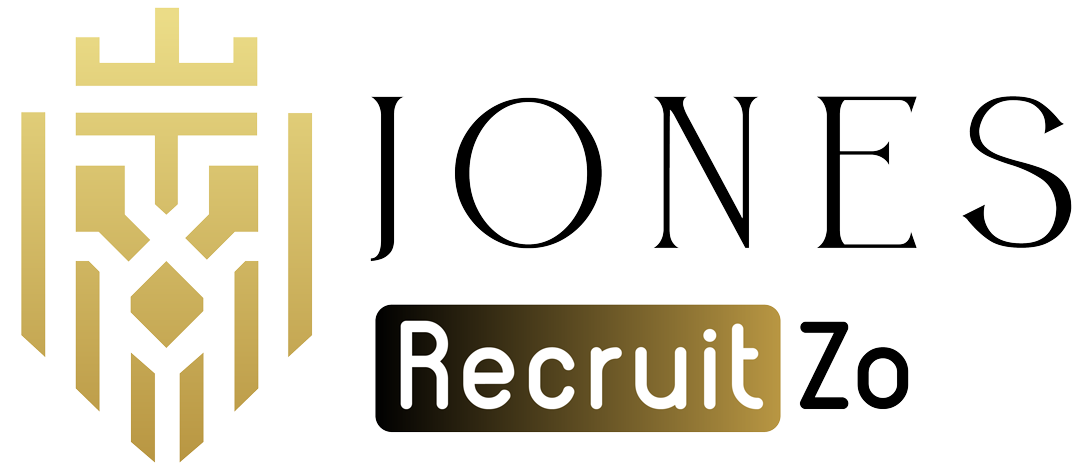What is a Skill Matrix?
A skill matrix is a chart that maps employees’ skills to those required by a given job, role, or project. It helps an organisation analyse its workforce capacity, track the areas of development, and better align talents to business needs. Usually drawing in table or grid format, the skill matrix presents a quick and effective way for one to determine who has what skill and at what proficiency level. It aids strategic planning as well as day-to-day management on departmental levels.
Why Is a Skills Matrix Important?
A skills matrix is important because it ensures that the right people are in the right jobs. By realising strengths and gaps across individuals or teams, companies can better plan for training, recruitment, and team building.
It facilitates workforce agility, with which the leaders would promptly deploy talent resources on real-time capability data. Whether for scaling out on a project or preparing for the future, the skills matrix is an excellent tool to depend upon.
Benefits of a Skill Matrix
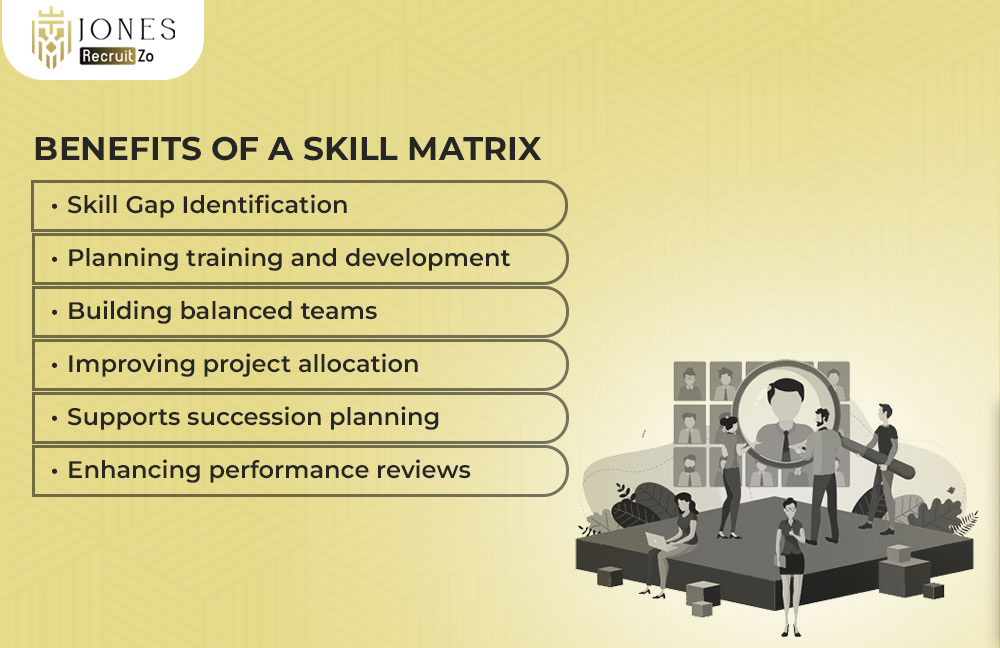
A well-designed skill matrix offers multiple benefits. Below are some of the top advantages organisations experience when using a skill matrix effectively.
Skill Gap Identification
This is one of the most direct benefits of a skills matrix; it shows where an individual or team lacks the required skills. This view allows HR and managers to address training and hiring needs proactively. It minimises downtime from missing expertise and keeps businesses from moving in the murky waters of hidden skill shortages.
Planning training and development
Once the skill matrix displays a clear picture of employee skill evaluation, businesses may design individual learning programmes. Otherwise, common resources allocated might contradict rationality. There can be a better ROI for the learning process that develops employees in areas of greatest concern to their role.
Building balanced teams
The skills matrix could help ensure that teams are evenly balanced in a variety of areas. It stands for forming diverse teams by bringing together people with complementary skills. This strategic alignment will give better-level teamwork and superior problem solving.
Improving project allocation
When project managers need to assign tasks, a skills matrix can quickly show who has the right skills to handle specific responsibilities. This ensures a smoother project flow and reduces reliance on guesswork. It also reduces bottlenecks by distributing work based on capability rather than availability alone.
Supports succession planning
For succession planning, it is essential to know who can hold leadership potential and who is ready to take on increased responsibilities. The skills matrix provides the view of tracking growth and potential across employees. This ensures that a critical role gets an alternative candidate for that position and that leadership can transition should the need arise.
Enhancing performance reviews
The performance review becomes less subjective with the support of skill data. A matrix offers managers a tangible tool in discussions about employee strength, progress, and potential areas for improvement. It also allows the employee to have some transparency and direction for their career development.
Components of a Skill Matrix
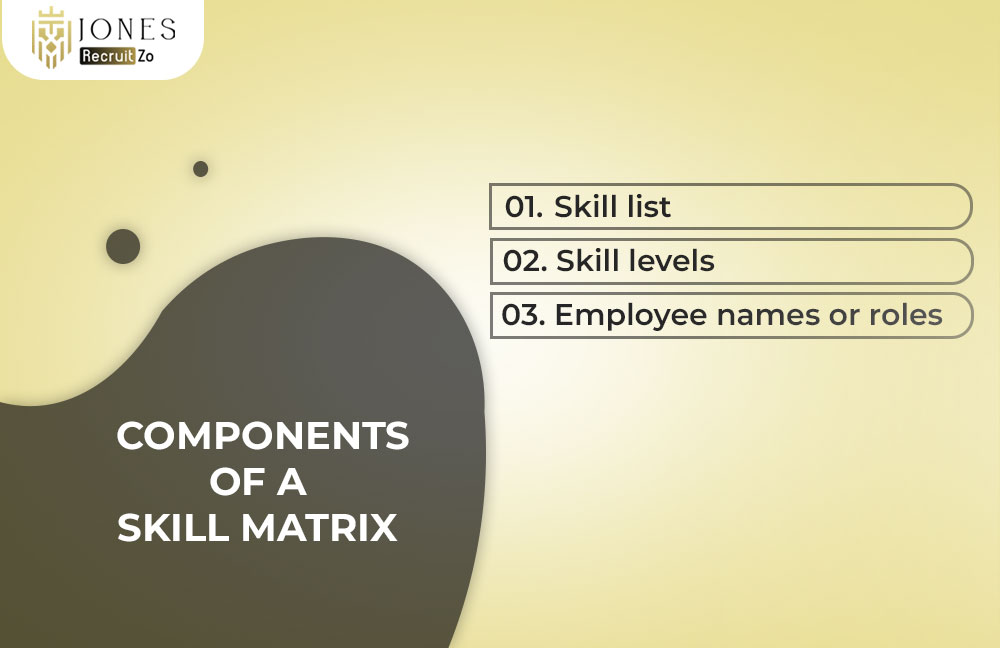
Understanding the building blocks of a skill matrix is essential for creating one that’s accurate and useful. Here are the core elements every effective skill matrix should include.
Skill list
This will include all relevant skills required for a particular job position, department, or project. The list should be customised to mirror the actual competencies required for success. Avoid generic or overly broad terms and instead focus on specific technical and soft skills.
Skill levels
Each skill is rated on a scale—commonly from beginner to expert—based on the employee’s proficiency. This could use numeric scales (e.g., 1 to 5) or descriptive levels (e.g., novice, intermediate, advanced). Consistency in rating is key to ensuring accurate comparisons across the team.
Employee names or roles
The matrix should clearly state who is being evaluated, either by the individual’s name or by roles if the matrix is being created at a team or departmental level. This helps in visualising team capacity and contributes towards decisions on staffing, promotions, or restructuring.
How to Create a Skill Matrix?
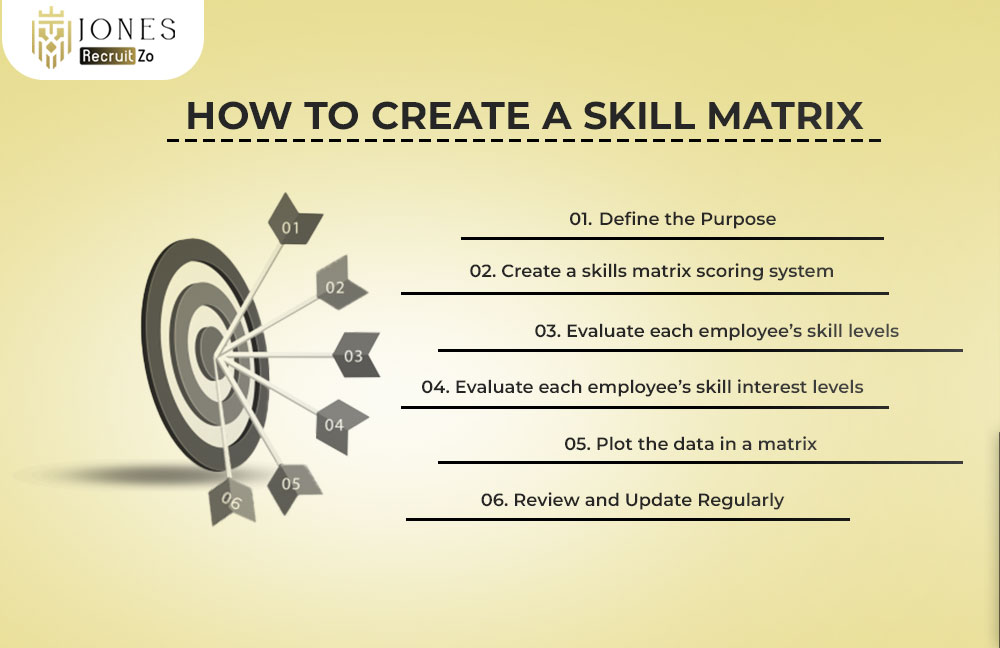
Creating a skill matrix involves careful planning, the right tools, and consistent updates. The following steps outline how to build a matrix that brings long-term value to your organisation.
Define the Purpose
Identify beforehand what the matrix will be used for-whether that might be team restructure, project planning, training, or performance management. This narrows down the skills and data points pertinent to each situation. An aligned objective ensures stakeholder buy-in and also significantly reduces the risk of collecting unnecessary information.
Create a skills matrix scoring system
Develop a consistent and clear system for rating skill levels. This could be numerical (e.g., 1 = beginner, 5 = expert) or descriptive. Make sure everyone understands how to apply the rating system to maintain accuracy. The scoring should reflect both ability and independence in performing the skill.
Evaluate each employee’s skill levels
Self-assessment and manager evaluation data are collected to know where each person is in a skill. Where possible, use objective criteria such as past performance and certifications. This double process limits bias and gives a bigger picture.
Evaluate each employee’s skill interest levels
Besides proficiency, gather information about the interest of the employee in developing certain skills. This becomes a future look and helps align training with personal motivation. High interest coupled with lack of skill currently is the perfect candidate for development investment.
Plot the data in a matrix
When skill levels and interest have been captured, plot the data onto the matrix. This may be done in a spreadsheet, in dedicated HR software, or in a visualisation tool. Make sure that it is easy to read and update. Use colours, filters, or tags to make vital information like skill gaps and top performers stand out.
Review and Update Regularly
A skills matrix does not come out in one go. It has to be updated at all instances as roles change and as employees grow. Establish a quarterly or biannual update schedule. Constant updating keeps it relevant and makes decisions that stem from the matrix accurate.
Common mistakes to avoid when building a skills matrix

Even a well-intentioned skills matrix can fall short if common pitfalls aren’t avoided. Here’s what to watch out for when designing and using your matrix.
Including irrelevant skills
Listing too many unnecessary skills is diluting the focus of the matrix. Only include those which are really essential to your business goals or the particular use case. Irrelevant information clutters the matrix and makes it less usable.
Using an Inconsistent Rating Scale
The different rating systems from different teams or assessors make the matrix unreliable. Ensure that the assessors use the same rating criteria. Train managers and employees on the rating method so that it will be uniformly applied.
Ignoring Employee Interest
Focusing only on current ability and not interest limits a matrix’s usefulness for long-term planning. Motivation of the employee will result in upskilling and retention. Include interest levels to help in identifying whom to groom as leaders or as experts in the future.
FAQs
1) What is a skill matrix?
A skills matrix is a tool used for visually mapping an employee’s skills against the competencies needed for a particular role or project. It helps understand the strengths and weaknesses of a workforce.
2) Why Is a Skills Matrix Important?
It is important because it leads to better decisions about hiring, training, team building, and succession planning. It is also helpful for the purposes of employee development and performance reviews.
3) What are the Benefits of a Skill Matrix?
The main benefits include skill gap analysis, better team structure, improved project allocation, and enhanced employee development.
4) How to Create a Skill Matrix?
Start by defining your purpose, creating a rating scale, assessing skills and interests, plotting the data, and regularly updating the matrix to stay relevant.







